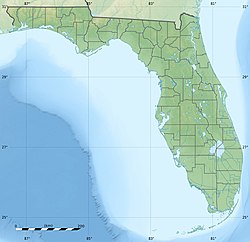
Back Fort Lauderdale Afrikaans Leoðeredælwīc ANG فورت لودرديل Arabic فورت لاودردال ARZ Fort Lauderdale (Florida) AST فورت لادردیل، فلوریدا AZB Форт-Лодердейл Bashkir Форт-Лодэрдэйл Byelorussian Форт Лодърдейл Bulgarian ফোর্ট লডারডেল, ফ্লোরিডা Bengali/Bangla
Fort Lauderdale | |
|---|---|
| Nickname: Venice of America | |
 Interactive map of Fort Lauderdale | |
| Coordinates: 26°8′N 80°9′W / 26.133°N 80.150°W | |
| Country | United States |
| State | Florida |
| County | Broward |
| Established | March 27, 1911 |
| Named for | William Lauderdale |
| Government | |
| • Type | Commission-Manager |
| • Mayor | Dean Trantalis (D) |
| • Vice Mayor | Pamela Beasley-Pittman |
| • Commissioners | Warren Sturman, Steven Glassman, John Herbst[1][2] |
| • City Manager | Greg Chavarria[1][3] |
| • City Clerk | David Soloman[1][4] |
| Area | |
• Total | 36.30 sq mi (94.01 km2) |
| • Land | 34.59 sq mi (89.58 km2) |
| • Water | 1.71 sq mi (4.44 km2) 4.71% |
| Elevation | 9 ft (2.75 m) |
| Population | |
• Total | 182,760 |
• Estimate (2022)[8] | 183,146 |
| • Rank | 140th in the United States 10th in Florida |
| • Density | 5,284.07/sq mi (2,040.21/km2) |
| Time zone | UTC−5 (Eastern (EST)) |
| • Summer (DST) | UTC−4 (EDT) |
| ZIP Codes | 33301–33332, 33334-33340, 33345–33346, 33348–33349, 33351, 33355, 33359, 33388, 33394[9] |
| Area codes | 754, 954 |
| FIPS code | 12-24000 |
| GNIS feature ID | 0282693[10] |
| Primary Airport | Fort Lauderdale-Hollywood International Airport |
| Website | www |
Fort Lauderdale (/ˈlɔːdərdeɪl/ LAW-dər-dayl) is a coastal city located in the U.S. state of Florida, 30 miles (48 km) north of Miami along the Atlantic Ocean. It is the county seat of and most populous city in Broward County with a population of 182,760 at the 2020 census,[7] making it the tenth-most populous city in Florida. After Miami and Hialeah, Fort Lauderdale is the third-most populous city in the Miami metropolitan area, which had a population of 6,166,488 in 2019.[11]
Built in 1838 and first incorporated in 1911, Fort Lauderdale is named after a series of forts built by the United States during the Second Seminole War.[12] The forts took their name from Major William Lauderdale (1782–1838), younger brother of Lieutenant Colonel James Lauderdale. Development of the city did not begin until 50 years after the forts were abandoned at the end of the conflict. Three forts named "Fort Lauderdale" were constructed including the first at the fork of the New River, the second at Tarpon Bend on the New River between the present-day Colee Hammock and Rio Vista neighborhoods, and the third near the site of the Bahia Mar Marina.[13]
Known as the "Venice of America", Fort Lauderdale has 165 miles of inland waterways across the city.[14] In addition to tourism, Fort Lauderdale has a diversified economy including marine, manufacturing, finance, insurance, real estate, high technology, avionics/aerospace, film, and television production. The city is a popular tourist destination with an average year-round temperature of 75.5 °F (24.2 °C) and 3,000 hours of sunshine per year. Greater Fort Lauderdale, encompassing all of Broward County, hosted more than 13 million overnight visitors in 2018.[15] Each year nearly four million cruise passengers pass through its Port Everglades, making it the third largest cruise port in the world.[16] With over 50,000 registered yachts and 100 marinas, Fort Lauderdale is also known as the yachting capital of the world."[17]
- ^ a b c "Municipal Directory: City of Fort Lauderdale". www.floridaleagueofcities.com. Archived from the original on March 1, 2019. Retrieved March 1, 2019.
- ^ "City of Fort Lauderdale, FL: City Commission". www.fortlauderdale.gov. Retrieved March 1, 2019.
- ^ "ABOUT THE CITY MANAGER'S OFFICE". www.fortlauderdale.gov. Archived from the original on March 1, 2019. Retrieved March 1, 2019.
- ^ "ABOUT THE CITY CLERK'S OFFICE". www.fortlauderdale.gov. Archived from the original on March 1, 2019. Retrieved March 1, 2019.
- ^ "2020 U.S. Gazetteer Files". United States Census Bureau. Retrieved October 31, 2021.
- ^ "Fort Lauderdale, United States Page". Falling Rain Genomics. Retrieved September 23, 2007.
- ^ a b "P2: HISPANIC OR LATINO, AND NOT ... - Census Bureau Table". P2 | HISPANIC OR LATINO, AND NOT HISPANIC OR LATINO BY RACE. U.S. Census Bureau. Retrieved March 21, 2023.
- ^ "Annual Estimates of the Resident Population for Incorporated Places in Florida: April 1, 2020 to July 1, 2022". Florida. U.S. Census Bureau. May 2023. Retrieved May 27, 2023.
- ^ "Fort Lauderdale, Florida Zip Code Boundary Map (FL)". Retrieved February 15, 2015.
- ^ "US Board on Geographic Names". United States Geological Survey. October 25, 2007. Retrieved January 31, 2008.
- ^ [chrome-ehttps://www.whitehouse.gov/wp-content/uploads/2020/03/Bulletin-20-01.pdf "Revised Delineations of Metropolitan Statistical Areas, Micropolitan Statistical Areas, and Guidance on the Uses of the Delineations of These Areas"] (PDF). Executive Office of the President. March 6, 2020. p. 59. Retrieved January 3, 2020.
- ^ "A look at Fort Lauderdale, from the 1880s to today". sun-sentinel.com. Retrieved February 14, 2022.
- ^ "Fort Lauderdale and the Second Seminole War". City of Fort Lauderdale. Retrieved February 14, 2022.
- ^ "About Fort Lauderdale". City of Fort Lauderdale, FL. Retrieved February 14, 2022.
- ^ "Visit Lauderdale Debuts as New Tourism Brand for Greater Fort Lauderdale During National Travel and Tourism Week" (Press release). PR Newswire. Retrieved February 14, 2022.
- ^ "See which Florida cruise ports are among the largest in the world". www.bizjournals.com. Retrieved February 14, 2022.
- ^ "Fort Lauderdale Yacht Charters | Tours, Taxis & Events". www.sunny.org. Retrieved February 14, 2022.









